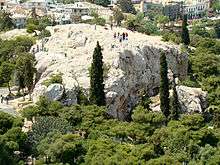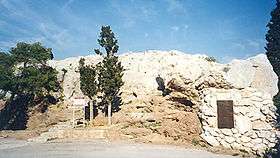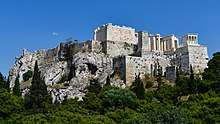Areopagus
The Areopagus (/ˌæriˈɒpəɡəs/) is a prominent rock outcropping located northwest of the Acropolis in Athens, Greece. Its English name is the Late Latin composite form of the Greek name Areios Pagos, translated "Hill of Ares" (Ancient Greek: Ἄρειος Πάγος). In classical times, it was the location of a court, also often called the Areopagus, that tried cases of deliberate homicide, wounding and religious matters, as well as cases involving arson or olive trees.[1][2] Ares was supposed to have been tried by the gods on the Areopagus for the murder of Poseidon's son Halirrhothius (a typical example of an aetiological myth).


History

The origin of the name is not clear. In Ancient Greek, πάγος pagos means "big piece of rock". Areios could have come from Ares or from the Erinyes,[3] as on its foot was erected a temple dedicated to the Erinyes where murderers used to find shelter so as not to face the consequences of their actions. Later, the Romans referred to the rocky hill as "Mars Hill", after Mars, the Roman version of the Greek God of War.[4] Near the Areopagus was also constructed the basilica of Dionysius Areopagites.
In pre-classical times (before the 5th century BC), the Areopagus was the council of elders of the city, similar to the Roman Senate. Like the Senate, its membership was restricted to those who had held high public office, in this case that of Archon.[5] In 594 BC, the Areopagus agreed to hand over its functions to Solon for reform. He instituted democratic reforms, reconstituted its membership, and returned control to the organization.[6]
Under the reforms of Cleisthenes enacted in 508/507 BC, the Boule (βουλή) or council was expanded from 400 to 500 men, and was formed of 50 men from each of ten clans or phylai (φυλαί).
In 462 BC, Ephialtes put through reforms which deprived the Areopagus of almost all its functions except that of a murder tribunal in favour of Heliaia.
In The Eumenides of Aeschylus (458 BC), the Areopagus is the site of the trial of Orestes for killing his mother (Clytemnestra) and her lover (Aegisthus).
Phryne, a hetaera of the 4th century BC who was famed for her beauty, appeared before the Areopagus accused of profaning the Eleusinian mysteries. One story has her letting her cloak drop and so impressing the judges with her almost divine form that she was summarily acquitted.[7]
In an unusual development, the Areopagus acquired a new function in the 4th century BC, investigating corruption, although conviction powers remained with the Ecclesia.
The Areopagus, like most city-state institutions, continued to function in Roman times, and it was from this location, drawing from the potential significance of the Athenian altar to the Unknown God, that the Apostle Paul is said to have delivered the famous speech, "Now what you worship as something unknown I am going to proclaim to you. The God who made the world and everything in it is the Lord of heaven and earth and does not live in temples built by hands." (Areopagus sermon, Acts 17:24)
The term "Areopagus" also refers to the judicial body of aristocratic origin that subsequently formed the higher court of modern Greece.
Modern references
- The English poet John Milton titled his defence of freedom of the press "Areopagitica", arguing that the censors of ancient Athens, based at the Areopagus, had not practiced the kind of prior restraint of publication being called for in the English Parliament of Milton's time.
- The Areopagus Society, formed in 1893, is one of the oldest clubs at the preparatory Hotchkiss School, Connecticut, USA, and meets to debate on certain topics.[8]
- "Areopagus" is the title of the second poem in Irish poet Louis MacNeice's 1952 collection, Ten Burnt Offerings.
See also
- Areopagus sermon
- Areopagus of Eastern Continental Greece, a regional Greek administration during the Greek Revolution of 1821, which was named after the Ancient Athenian institution.
Footnotes
- MacDowell, Douglas M. (1978). The law in classical Athens. Ithaca, N.Y.: Cornell University Press. p. 27. ISBN 9780801493652. OCLC 20663324.
- Pseudo-Aristotle. "Atheneion Politeia". Perseus. Perseus Tufts. Retrieved 8 February 2016.
- Modern writers (C. Wachsmuth, Die Stadt Athen, 1. p. 428 note 2; G. Gilbert, Griech. Staatsalterthiimer,2 1. p. 425 note 4) have suggested that Areopagus (Areios pagos) means 'the hill of cursing,' the first part of the name being derived from ara 'a curse' and the reference being to the Furies who had a sanctuary on the side of the hill, and were sometimes known as Arai, i.e. 'the curses' (Aeschylus, Eumenides, 417)
- New American Bible
- Aristotle, Constitution of the Athenians §3
- Ancient Greece:Athens Archived December 3, 2010, at the Wayback Machine
- (Athenaeus, Deipnosophistae, XIII.590)
- "Hotchkiss Timeline". www.hotchkissmedia.org. Retrieved 2017-12-11.
Further reading
External links
| Wikimedia Commons has media related to Areopagus. |
- Acts 17:16-34 – A Biblical account of St. Paul discussing with the Areopagus the nature of the Christian God. Also referred to is the story concerning the altar to "The Unknown God."
- Athens Photo Guide


